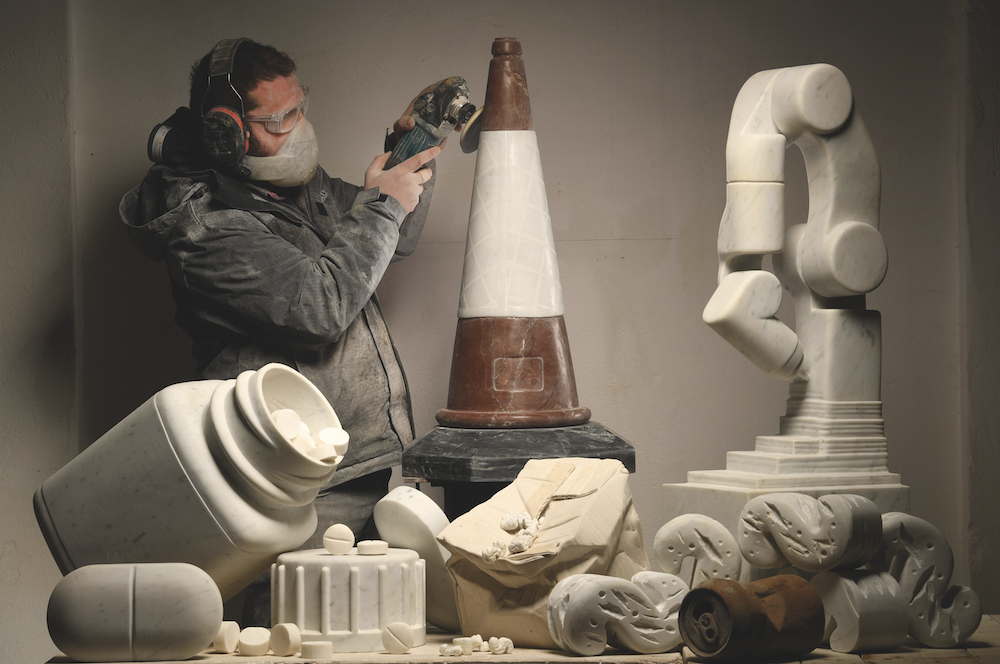Tom Waugh MRSS is a sculptor working with natural stone and has been an associate member of the Royal Society of Sculptors since 2018. After gaining a First in Architectural Stone Carving at the City and Guilds of London Art School, he went on to produce work for St Pancras Station, St Martin in the Fields and St George’s Chapel, Windsor. You can also see his work in the collections of Warwick University, Gladstone’s Library and Messums Wiltshire. He has previously spent time in India studying traditional carving techniques with the temple carver Raja Saceran and takes inspiration from crushed and squashed objects that are often overlooked. We catch up with him to find out more.
Can you tell us how you got into stonemasonry?
In 2002, I was unemployed and living in Bristol. There was a church being restored in St Pauls near where I lived, and I was fascinated by seeing the masons working stone at the bottom of the scaffold. I asked the head mason if he would take me on and I quickly progressed from sweeping up to fixing and working stone. I studied stonemasonry for a year while I was working at St Paul’s Church and then moved to London to complete a three-year diploma in Architectural Stone Carving at the City and Guilds of London Art School. The course focused on figurative and decorative carving, but my foundation in stonemasonry was invaluable. I went on to work on conservation and restoration of historic buildings and monuments including St Paul’s Cathedral, St Martin in the Fields and the Perseus and Andromeda Fountain at Witley Court.
What inspires you?
I take inspiration from many sources but at the most basic level I like forms that are crushed or squashed. One of the first pieces that I carved was a crushed cardboard box that reminded me of classical and baroque drapery. This theme appears consistently throughout my work.
What reaction do you hope your work will provoke?
I hope my work is enjoyed by a wide range of people, I try to make work that I would like to see, and I often use humour to convey a more serious message.
Can you talk about your artistic process?
In my work I represent everyday objects in stone and marble. I select different materials that share qualities with the objects that I am representing. I recently carved a wheelie bin using grey marble to look like plastic and a jerry can in ironstone that looks like rusty metal. There is always a seed of an idea that will sit with me for a while before I commit to it, sometimes after several years. For me the message is as important as the finished object but I like my work to stand alone, without the need for an accompanying text. I am always trying to push the boundaries of what is possible in stone and I hope this will play a small part in moving the craft forward.
Do you have a dream commission?
I have completed a number of public art commissions and I always love the opportunity to see my work in shared spaces. My dream commission would be a large-scale stone sculpture in a prominent public space as previous commissions have been smaller or on housing developments where they are not seen so much.
Where would you most like to see your work placed?
In a city centre, maybe Bristol or London.
In terms of materials, what is your preferred stone to work with?
I love the results of working with marble but the finishing takes a lot longer than limestone. I also like Great Tew Ironstone – it is tricky to carve because it is so inconsistent but it has a rusty metal look which I love. The stone that is nicest to carve are some of the French limestones like Caen or Lavoux.
Hand tools or machines?
I use a combination of traditional techniques and modern tools. For my 1:1 sculptures I will sometimes use a pointing machine for accuracy, and to scale up I use proportional calipers. I start roughing out with angle grinders and I move on to pneumatics. I always finish with a hammer and chisel. All tools have their place if used correctly and not overused.
Do you worry that the art of stonemasonry is dying?
I do worry that a lot of traditional skills are in danger of dying out, including stonemasonry. There will always be a need for hand cut stone to preserve our built heritage and stone and marble will continue to be used for sculpture but as a trade I think it is definitely under threat.
Whose work do you admire most?
The sculptor that I keep coming back to is Gian Lorenzo Bernini. His ability to transform hard marble into soft flesh or flowing drapery is extraordinary. I am always looking for sculpture that confounds expectation, where it is not immediately clear how it was made or what from. Richard Wilson’s installation ‘20:50’ had this effect on me when I saw it in 2003. He uses crude oil to fill a gallery with a walkway going out to the middle of the space. This creates a surface so reflective that it initially appears to be empty space.
To find out more, visit: tomwaugh.com

